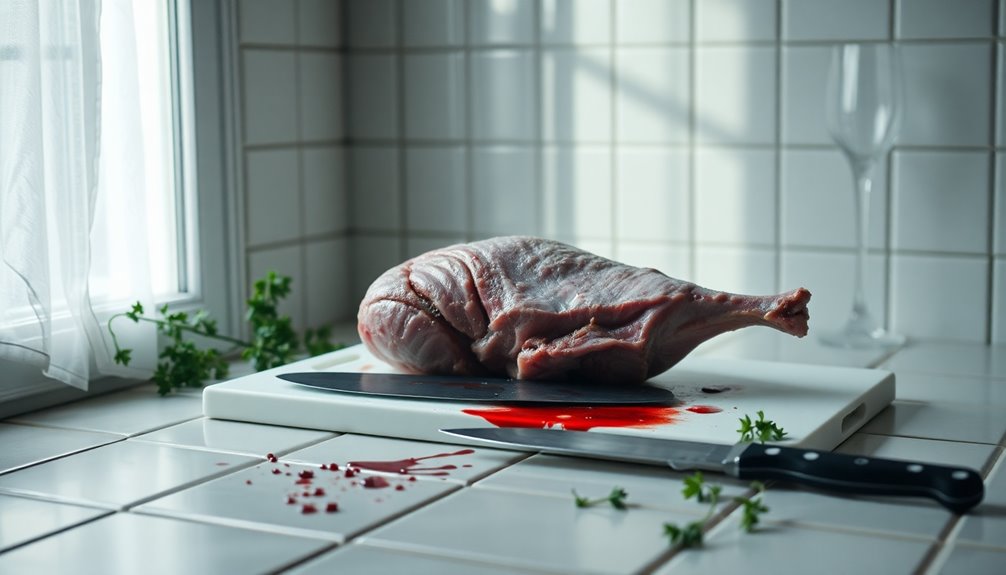In Roald Dahl's "Lamb to the Slaughter," the lamb symbolizes innocence and betrayal. At first, Mary Maloney is a loving wife, but when her husband Patrick announces his desire to leave, everything changes. The frozen leg of lamb becomes her unexpected weapon, showing how nurturing can twist into violence. This clever twist highlights the hidden dangers within a seemingly cozy home. Ironically, the detectives unknowingly eat the very evidence they seek! This combination of symbols adds depth to Mary's transformation and the story's themes of betrayal. There's so much more to uncover about this fascinating tale waiting for you!
Key Takeaways
- The lamb symbolizes innocence and the betrayal of Mary Maloney's domestic role, highlighting her transformation from nurturing wife to murderer.
- The frozen leg of lamb serves dual purposes as both a meal and a murder weapon, illustrating hidden violence in domestic life.
- The title "Lamb to the Slaughter" reflects naivety and impending danger, contrasting a peaceful home with erupting violence.
- Irony plays a significant role, with detectives unknowingly consuming the murder weapon, emphasizing the story's clever twists and dark humor.
- The symbolism of domesticity juxtaposed with violence critiques societal expectations and reveals the complexities of human relationships and hidden dangers.
Overview of the Story

In "Lamb to the Slaughter," Roald Dahl crafts a gripping tale that explores the complexities of marriage and the extremes of human emotion. You meet Mary Maloney, a seemingly devoted wife who loves her husband, Patrick. But when he shockingly announces he's leaving her, everything changes. In a moment of rage, Mary reacts violently, killing him with a frozen leg of lamb. This moment marks a dramatic shift from a loving wife to a figure of violence.
Dahl masterfully uses irony throughout the story. After the murder, Mary cooks the leg of lamb and serves it to the detectives investigating her husband's disappearance. They've no idea that the meal contains the very weapon they're searching for!
The lamb, which symbolizes both innocence and sacrifice, contrasts sharply with Mary's drastic actions. You can't help but feel a mix of tension and dark humor as the story unfolds.
Ultimately, "Lamb to the Slaughter" invites you to think about how quickly situations can change and reveals the unexpected sides of human nature. It's a thrilling read that keeps you wondering what might happen next!
Symbolism of the Lamb
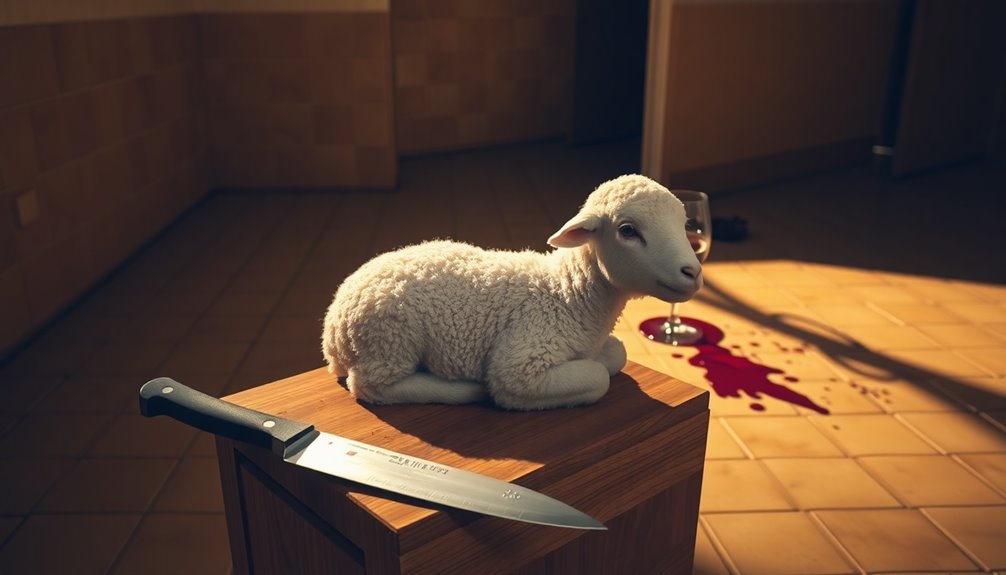
Let's explore the powerful symbolism of the lamb in "Lamb to the Slaughter"!
The lamb represents innocence and betrayal, showing how Mary Maloney changes from a sweet wife to a clever murderer.
As we look closer, we'll see how this frozen leg of lamb highlights the surprising mix of domestic life and hidden violence, making the story even more thrilling!
Innocence and Betrayal
The symbolism of the lamb in "Lamb to the Slaughter" intricately weaves together themes of innocence and betrayal, illustrating Mary Maloney's shocking transformation. At first, the lamb represents Mary's innocence and domesticity. She's a loving wife, caring for her husband, Patrick.
But things take a dark turn. When Patrick reveals he wants a divorce, Mary feels betrayed. This betrayal triggers a drastic change in her character.
The frozen leg of lamb becomes a powerful symbol. It shows both her role as a nurturing wife and the violent act she commits. It's ironic how something meant for a comforting dinner turns into a weapon.
The title itself, "Lamb to the Slaughter," hints at naivety. Patrick doesn't realize the danger he's in, believing Mary remains the devoted wife he knows.
As you read, you'll notice how the lamb's symbolism highlights the contrast between a peaceful home and the violence that erupts. It critiques how society expects women to fit into certain roles, even when they're pushed to their limits.
Mary's story reminds us that innocence can hide deep feelings, making betrayal even more shocking.
Transformation of Mary Maloney
Mary Maloney's transformation unfolds dramatically as she shifts from a devoted wife to a cunning murderer, showcasing the powerful symbolism of the lamb. At first, you see her as a picture of innocence and submission, perfectly embodying the lamb's symbolism with her nurturing demeanor.
But everything changes when she uses the frozen leg of lamb to murder her husband, Patrick. This moment marks a bold transformation, as she rejects her victimhood and takes control.
The leg of lamb, once a symbol of her domesticity, becomes a tool of violence. As Mary cooks it to hide her crime, she cleverly turns the lamb's symbolism on its head. Instead of being a sacrificial victim, it now represents her cunning and vengeful nature.
When she serves the cooked leg of lamb to the detectives, you can see her complete shift. She's no longer the innocent wife; she's a calculated manipulator, reveling in her new power.
This transformation is thrilling! Mary Maloney shows how one event can change a person's life forever, turning a symbol of innocence into one of revenge and strength. What a fascinating journey!
#
Domesticity and Violence
In "Lamb to the Slaughter," the stark contrast between domesticity and violence is vividly illustrated through the symbolism of the lamb. At first, the lamb represents Mary Maloney's innocent and nurturing side as a devoted wife. However, things take a dark turn when the frozen leg of lamb becomes a weapon, changing from a meal to a tool of murder. This alteration highlights how domestic life can hide dangerous secrets.
Here's a table to help you visualize this contrast:
| Symbol | Meaning |
|---|---|
| Lamb | Innocence and submission |
| Frozen leg of lamb | Shift to violence |
| Cooking | Shift from victim to aggressor |
| Domestic setting | Hiding dark intentions |
Mary's act of cooking the leg of lamb turns the symbol of home into a tool for murder. The title "Lamb to the Slaughter" connects to biblical sacrifice, showing how Mary becomes both innocent and violent. The story teaches us that even the coziest homes can hide turmoil, as represented by the dual symbolism of the lamb. Isn't it fascinating how one symbol can tell such a powerful story?
Mary Maloney's Transformation

Mary Maloney's transformation is quite fascinating!
She starts as a loving wife but quickly shifts to a clever strategist after her husband's cruel betrayal.
This change shows how she goes from devotion to revenge, using her smarts to manipulate the situation and take control of her life.
From Devotion to Revenge
Devotion can quickly turn into something darker when a betrayal strikes at the heart of a relationship.
Mary Maloney starts as a loving wife, caring deeply for her husband. But when he suddenly reveals his intention to leave her, everything changes. This betrayal ignites a fierce transformation within her. The frozen leg of lamb, once a symbol of nourishment, becomes a weapon of revenge.
Mary's calm demeanor after the shocking act of murder shows just how much she's changed. Instead of panicking, she cleverly cooks the leg of lamb, turning the evidence into a meal. This clever move hides her crime while showcasing her cunning nature.
As you read, you can see how Mary evolves from a devoted partner into an empowered survivor. The story beautifully illustrates how betrayal can flip the power dynamics in a relationship.
Mary's journey reflects a deep emotional shift, reminding us that love can twist into something unexpected. Through her actions, you realize that even the gentlest souls can change dramatically when faced with betrayal.
Mary's transformation is both thrilling and chilling, drawing you into her complex world of revenge.
Strategic Manipulation of Circumstances
Betrayal not only reshapes relationships but also reveals hidden depths of character.
After Mary Maloney kills her husband, she doesn't just panic; she transforms. This shift shows her strategic manipulation of circumstances. Instead of falling apart, Mary taps into her newfound agency. She quickly thinks through her next steps, demonstrating a survival instinct that surprises even her.
Mary cleverly constructs an alibi by inviting the detectives to dinner, serving them the cooked leg of lamb—the very weapon of her crime! This act is filled with irony.
While they munch away, they've no clue that Mary is cleverly controlling the situation. Her calm demeanor after the murder highlights her change from emotional chaos to calculated composure.
Irony in the Narrative
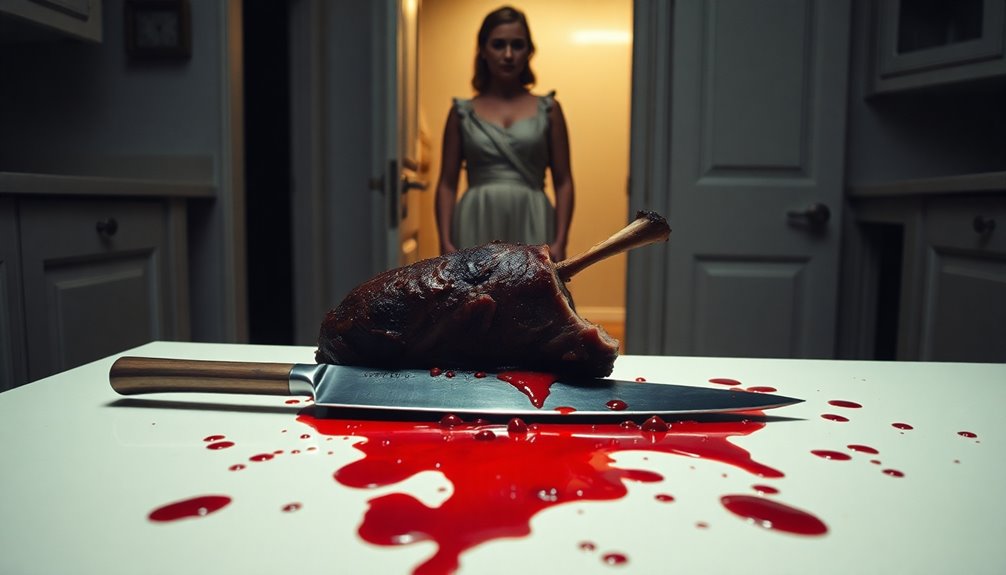
Irony frequently permeates the narrative of "Lamb to the Slaughter," transforming the mundane into the shocking. You might find it surprising how Mary Maloney, who seems so innocent and nurturing, turns into a murderer using a leg of lamb. This leg of lamb isn't just a dinner item; it's a symbol of domestic life and hospitality. Yet, it becomes the murder weapon, showing a wild twist in the story.
As you read, you notice the detectives casually eating the cooked leg of lamb. They're talking about the murder, completely unaware they're munching on the evidence! This adds to the irony, making you chuckle while feeling uneasy.
Then, there's Patrick Maloney, who dismisses Mary. His fate is tragically ironic, as he becomes the victim of her unexpected transformation into an aggressor.
The title "Lamb to the Slaughter" also plays with irony. At first, Mary seems like the sacrificial lamb, but she flips the script and takes control. This clever use of irony keeps you on your toes, making the story not just interesting but truly unforgettable. Additionally, the story highlights how trust-building activities can shift the dynamics of relationships, revealing the unexpected consequences when that trust is broken.
Character Analysis: Mary Maloney
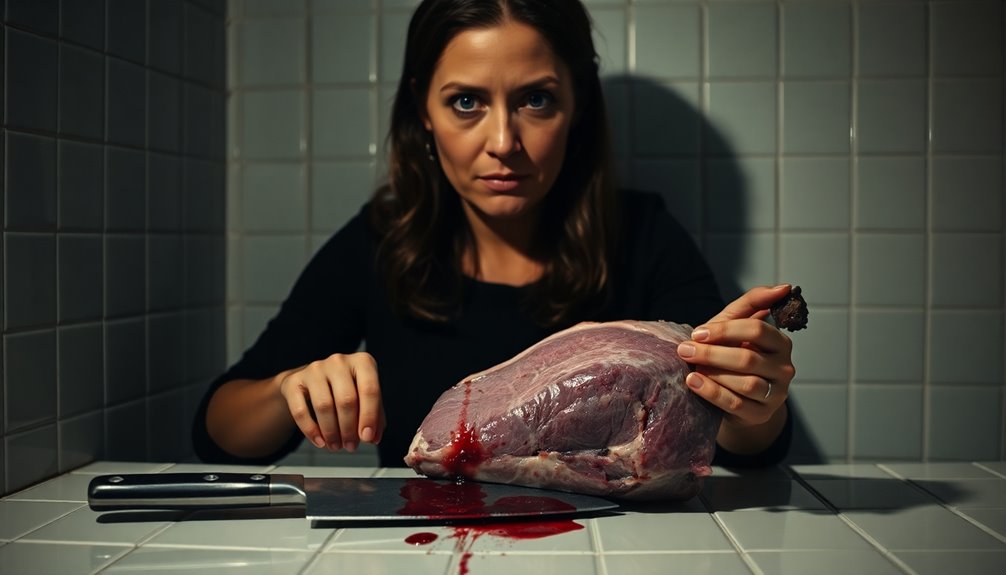
Mary Maloney presents a striking contrast to the violence that unfolds in "Lamb to the Slaughter." At first, she embodies the ideal housewife, meticulously attending to her home and husband, Patrick, with warmth and care. However, after Patrick's betrayal, you see a dramatic transformation. Mary evolves from a devoted wife into a calculating murderer, revealing her inner strength and cunning.
The leg of lamb symbolizes this duality. It represents both her nurturing side and her capacity for violence when pushed too far. Throughout the story, Mary cleverly manipulates the situation to her advantage. She constructs an alibi and hides the murder weapon from the detectives, showcasing her intelligence.
Here's a quick look at her character development:
| Quality | Before Patrick's Betrayal | After the Murder |
|---|---|---|
| Role | Ideal Housewife | Cunning Manipulator |
| Symbolism | Nurturing | Leg of Lamb (Violence) |
| Emotional State | Loving and Submissive | Empowered and Calculating |
| Outcome | Passive Victim | Victorious Survivor |
Character Analysis: Patrick Maloney
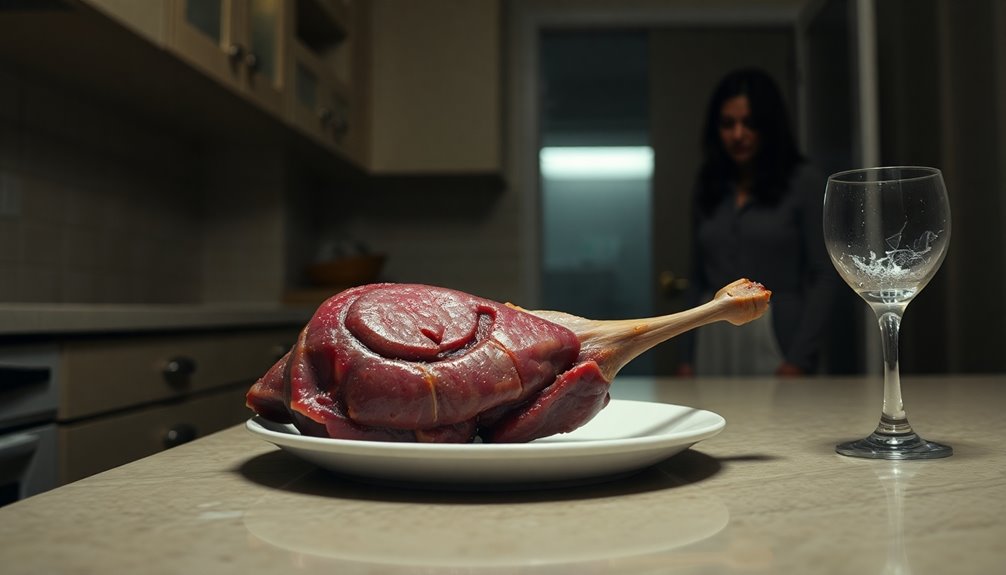
Let's take a closer look at Patrick Maloney, the husband in "Lamb to the Slaughter."
He seems so confident and in control, but his behavior shows a different side.
Patrick's betrayal and neglect create a big problem, and his arrogance leads to surprising consequences that change everything!
Patrick's Authoritative Demeanor
Patrick Maloney's authoritative demeanor stands out starkly in his interactions with Mary, revealing the deep-seated power dynamics in their marriage. You can see this when he speaks to her dismissively, making it clear he believes he holds the upper hand. His abrupt announcement about ending their marriage shows a complete emotional neglect for Mary's feelings, which is quite shocking. It's like he doesn't even consider how this news will affect her.
This behavior showcases the traditional roles they play, with Patrick embodying patriarchal authority. He seems to ignore the loving, careful home Mary has created for them, which highlights his disconnect. While she puts so much effort into their life together, he remains emotionally withdrawn. This imbalance intensifies the conflict between them, leading to a dramatic transformation in Mary.
When Patrick meets his end, it's a powerful shift in the story. His death symbolizes the heavy consequences of his authoritarian ways and the emotional betrayal he inflicted on Mary. This moment reminds us that ignoring someone's feelings can lead to serious repercussions, highlighting the importance of understanding and respect in any relationship.
Betrayal and Emotional Neglect
In the story, Patrick Maloney's abrupt announcement of divorce cuts through the fabric of his marriage with Mary, revealing a profound sense of betrayal. His actions show emotional neglect, as he dismisses all the love and effort Mary put into their domestic roles.
Patrick's cold demeanor makes it clear he doesn't value her sacrifices.
Here are some key points about his character:
- Betrayal: Patrick shatters their bond with one heartless statement.
- Emotional Neglect: He overlooks Mary's feelings, leaving her feeling isolated.
- Domestic Roles: Patrick doesn't appreciate the work Mary does at home.
- Symbolism: The meal she prepares symbolizes her devotion, which he disregards.
- Power Dynamics: His authoritative attitude creates a rift in their relationship.
This emotional neglect leads to a tragic outcome. The contrast between his coldness and Mary's love highlights the expectations of masculinity.
In the end, Patrick's betrayal doesn't just hurt Mary; it leads to his own downfall. By neglecting her emotionally, he sets the stage for his own tragic fate.
Consequences of Arrogance
The consequences of arrogance manifest starkly in Patrick Maloney's character. He shows arrogance through his dismissive attitude, especially when he suddenly announces his wish for a divorce. Patrick doesn't seem to care about how much this hurts Mary, who's always been devoted to him. This lack of consideration leads to dire consequences.
In this story, he embodies the traditional male authority figure, believing he can control the relationship. The irony is clear: he thinks he's strong, but his arrogance makes him vulnerable. By underestimating Mary's emotional depth, he sets the stage for his own demise.
Patrick's failure to recognize Mary's feelings shows how taking a partner for granted can backfire. Instead of seeing her as someone capable of resilience, he views her as submissive. This blindness to her emotional strength ultimately costs him dearly.
When he treats her with indifference, he opens the door to unexpected outcomes. Readers can see how arrogance blinds him to the truth around him. In the end, Patrick's story reminds us that arrogance can lead to devastating consequences, especially when we fail to appreciate those we love.
Role of the Detectives
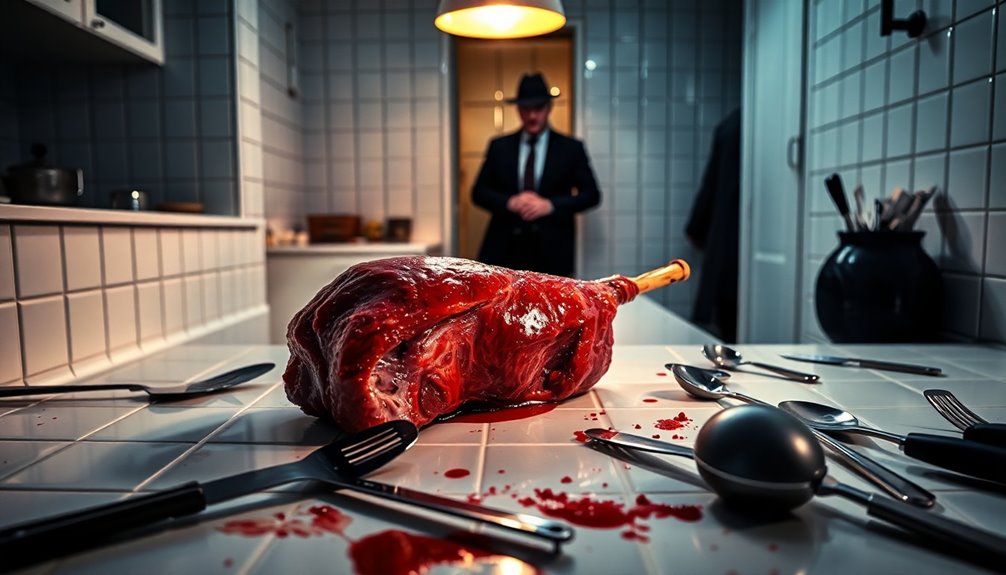
While investigating the murder in "Lamb to the Slaughter," the detectives embody societal norms and the expectation of order, highlighting the law's quest for truth amidst chaos. You can see how their traditional methods shape the story's irony. They focus heavily on finding the murder weapon, but they overlook vital evidence right under their noses!
Here are some key aspects of the detectives' role in the story:
- They represent societal norms, emphasizing order and justice.
- Jack Noonan's familiarity with Mary Maloney adds to the irony of the situation.
- Their assumptions lead to dramatic irony; they don't realize Mary's guilt.
- The detectives' investigation is filled with dark humor, especially when they unknowingly eat the murder weapon!
- Their failure to recognize the leg of lamb as evidence is comically tragic.
The detectives' interactions and methods show how easily they can be misled. Their obliviousness adds an exciting twist to the narrative, making readers chuckle at the dark humor while questioning how well they truly understand the situation.
Themes of Betrayal and Revenge
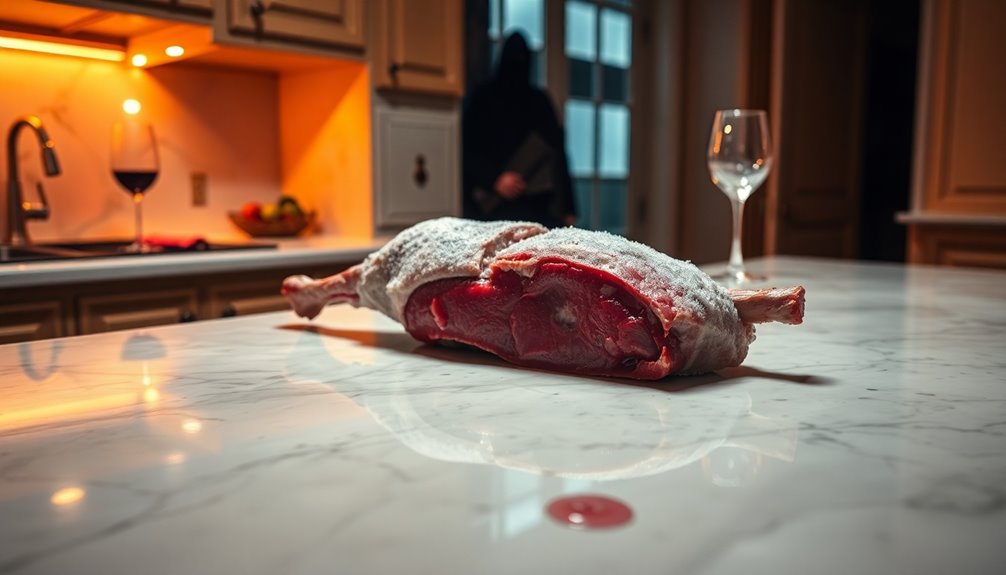
At the heart of "Lamb to the Slaughter" lies a chilling exploration of betrayal and revenge, where Mary Maloney's world shatters with her husband's abrupt announcement of his intent to leave her. This shocking moment reveals deep betrayal, breaking the trust Mary had in her husband, Patrick. It ignites a fierce reaction within her, transforming her from a caring wife into a cunning figure seeking revenge.
Mary's choice of weapon, the leg of lamb, symbolizes innocence, making the violent act even more ironic. She cleverly uses this ordinary item to conceal her crime, turning it into a tool of power. This transformation showcases how betrayal can drastically change a person's identity. Instead of being submissive, Mary reclaims her agency in a world that often expects women to be passive. Interestingly, this reflects how individuals can experience significant personal change following traumatic experiences, leading to unexpected outcomes. Moreover, the unpredictable nature of betrayal can result in individuals needing to establish advance directives to ensure their wishes are respected in times of crisis. Research indicates that professional help can be beneficial in processing such profound emotional changes.
Through this story, we see a critique of traditional gender roles. Patrick's betrayal pushes Mary to challenge societal expectations, taking control in an unexpected way. This narrative can be likened to the concept of emotional alignment, emphasizing how personal transformations can arise from traumatic experiences.
In the end, "Lamb to the Slaughter" becomes not just a tale of revenge, but a powerful reminder of how betrayal can ignite a fierce transformation in a person's life.
## Domesticity and Violence

Often, domestic settings mask underlying tensions that can erupt into violence, as seen in "Lamb to the Slaughter." Mary Maloney's seemingly peaceful home becomes the stage for a shocking act of murder, revealing how domesticity can conceal dark realities. The frozen leg of lamb symbolizes this clash. It starts as a nurturing element but transforms into a weapon of destruction.
Here are some key points to reflect upon:
- The cozy home contrasts sharply with the shocking violence that occurs.
- The leg of lamb changes from a meal to a murder weapon, showing how quickly things can turn.
- Mary's role as a devoted wife is turned upside down by her violent act.
- The irony of her preparing a meal for detectives while hiding the leg of lamb adds a twist to the story.
- This situation highlights the hidden dangers lurking within domestic life.
In "Lamb to the Slaughter," the mix of domesticity and violence creates a gripping story. It reminds us that what seems safe can sometimes hide unexpected dangers. The transformation of Mary Maloney emphasizes the complexities of human nature in familiar settings.
Impact of Dark Humor
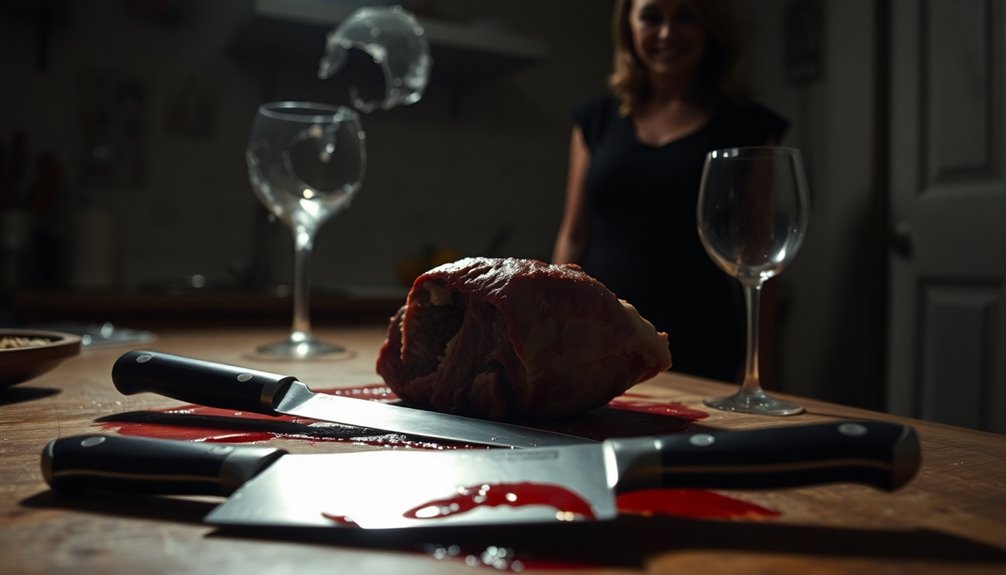
Dark humor plays an essential role in "Lamb to the Slaughter," as it juxtaposes the absurdity of a domestic scene with the brutality of murder. This clever use of dark humor captures your attention and makes you think. You might find it surprising how a cozy dinner can turn into a shocking crime.
Here's a table to illustrate the contrast:
| Scene Description | Symbolism | Emotional Response |
|---|---|---|
| Mary prepares dinner | Domesticity | Comfort and safety |
| The murder happens | Violence | Shock and disbelief |
| Detectives arrive | Irony | Humor mixed with tension |
| Mary serves the leg of lamb | Dark humor | Amusement and surprise |
| The detectives eat the weapon | Irony | Dark laughter |
The ironic twist of Mary serving the cooked leg of lamb to the detectives adds a funny yet chilling element. This highlights the strange mix of domesticity and violence. Dahl's dark humor challenges your ideas about right and wrong, making you ponder human behavior and justice. It entertains while exploring serious themes like betrayal and revenge. Overall, it keeps you engaged and curious about what happens next! Additionally, the story reflects the complexity of self-reflection as characters navigate their emotions and choices.
Frequently Asked Questions
What Does the Lamb Symbolise in the Lamb?
In the story, the lamb symbolizes innocence and purity. It represents Mary Maloney's gentle nature as a devoted wife.
However, this symbol twists when she uses the frozen leg of lamb as a weapon. Instead of staying innocent, she transforms into someone capable of revenge.
This contrast shows how appearances can be deceiving. So, the lamb becomes a powerful symbol of how Mary changes from sweet to fierce, surprising everyone around her!
What Does Alcohol Symbolize in Lamb to the Slaughter?
Alcohol in "Lamb to the Slaughter" acts like a mask, hiding Mary's true feelings. It shows how she tries to keep things normal, even when her world is falling apart.
When she offers Patrick a drink, it's her way of keeping peace at home.
After the shocking event, Mary cleverly uses alcohol to distract from her guilt. The detectives, unaware of her tricks, focus on the drinks instead of her hidden emotions.
What Do the Ice Cubes Symbolize in Lamb to the Slaughter?
In "Lamb to the Slaughter," ice cubes symbolize the coldness and distance in Mary's marriage.
When you see her preparing drinks, it shows how she's trying to keep things normal.
But those ice cubes also contrast sharply with the shocking moment when her husband makes a hurtful announcement.
As they melt, they represent the quick loss of Mary's innocence and the sudden change in her emotions, highlighting the story's surprising twists!
What Is the Allusion of Lamb to the Slaughter?
Like a surprise party gone wrong, the allusion in "Lamb to the Slaughter" cleverly hints at deeper meanings.
It connects to the idea of innocent lambs, symbolizing Mary Maloney's initial sweetness and later shocking actions. Just as a lamb heads to its fate unaware, Mary's husband, Patrick, doesn't see the danger coming.
This twist makes you think about how appearances can be deceiving and how unexpected events can change everything in an instant!
Conclusion
In "Lamb to the Slaughter," the symbolism of the lamb shows how innocence can hide darker truths. Mary Maloney's transformation from a loving wife to a clever murderer is both surprising and thrilling. The story teaches us about betrayal, revealing how appearances can be deceiving. So, next time you think you know someone, remember Mary. Sometimes, the most unsuspecting people can have secrets that shock us, just like a hidden treasure waiting to be found!

